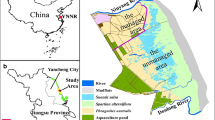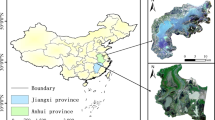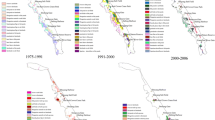Abstract
Identifying the breeding habitat of red-crowned crane (Grus japonensis) is essential for the management and conservation of this rare species. In the current study, we built a habitat suitability index (HSI) model for the breeding red-crowned crane in wetlands of the Zhalong National Nature Reserve of the Songnen Plain, China. The assessing factors to construct the HSI model were selected according to the habitat requirements of red-crowned crane in the breeding period, including the potential nest site (emergent marsh), habitat composition (the area percentage of emergent marsh in species home range), water depth, vegetation cover, and distance to human disturbance. Efficient techniques have been used to quantify predictor variables using multi-source data (i.e. optical imagery, radar imagery and ancillary topographic data). In addition, we illustrated the extraction method of habitat factors in detail and the significances of these factors in evaluating the breeding habitat suitability for the red-crowned crane. Analysis results indicated that the GIS-based HSI model successfully identified potentially suitable red-crowned cranes nesting sites. This analysis not only enables wildlife managers to identify priority locations and conservation status for red-crowned crane, but also provides an effective and prompt method that can be used to infer other waterfowl species nest sites.









Similar content being viewed by others
References
Armbruster MJ (1987) Habitat suitability index models: greater sandhill crane. U.S. Fish and Wildlife Service. Biol Reprod 140:82–10
Baker BW, Cade BS, Mangus WL, McMillen JL (1995) Spatial analysis of Sandhill crane nesting habitat. J. Wildl Manag 59:752–758
Bateson A, Asner GP, Wessman CA (2000) Endmember bundles: a new approach to incorporating endmember variability in spectral mixture analysis. IEEE Trans Geosci Remote Sens 38:1083–1094
Beijma SV, Comber A, Lamb A (2014) Random forest classification of salt marsh vegetation habitats using quad-polarimetric airborne SAR, elevation and optical RS data. Remote Sens Environ 149:118–129
Boardman JW, Kruse FA, Green RO (1995) Mapping target signatures via partial unmixing of AVIRIS data. In Fifth JPL Airborne Earth Science Workshop pp:23–26
Burnham KP, Anderson DR (2002) Model selection and multimodel inference: a practical information-theoretic approach, second edn. Springer-Verlag, NewYork
Cao MC, Liu GH (2008) Habitat suitability change of red-crowned crane in yellow river delta nature reserve. J For Res 19:141–147
Carter GM, Stolen ED, Breininger DR (2006) A rapid approach to modeling species–habitat relationships. Biol Conserv 27:237–244
Congalton RG (1991) A review of assessing the accuracy of classifications of remotely sensed data. Remote Sens Environ 37:35–46
Dong ZY, Wang ZM, Liu DW, Li L, Ren CY, Tang XG, Jia MM, Liu CY (2013) Assessment of habitat suitability for waterbirds in the west songnen plain, China, using remote sensing and GIS. Ecol Eng 55:94–100
Downs JA, Gates RJ, Murray AT (2008) Estimating carrying capacity for sandhill cranes using habitat suitability and spatial optimization models. Ecol Model 214:284–292
ENVI (2000) ENVI user’s guide. Inc, Research System
Evans TL, Costa M, Tomas WM, Camilo AR (2014) Large-scale habitat mapping of the Brazilian Pantanal wetland: a synthetic aperture radar approach. Remote Sens Environ 155:89–108
Foody GM, Cutlerb EJ (2006) Mapping the species richness and composition of tropical forests from remotely sensed data with neural networks. Ecol Model 195:37–42
Gillenwater D, Granata T, Zika U (2006) GIS-based modeling of spawning habitat suitability for walleye in the Sandusky river, Ohio, and implications for dam removal and river restoration. Ecol Eng 28:311–323
Green AA, Berman M, Switzer P, Craig MD (1988) A transformation for ordering multispectral data in terms of image quality with implications for noise removal. IEEE Trans Geosci Remote Sens 26:65–74
Grings FM, Ferrazzoli P, Jacobo-Berlles JC, Karszenbaum H, Tiffenberg J, Pratolongo P (2006) Monitoring flood conditions in marshes using EM models and envisat ASAR observations. IEEE Trans Geosci Remote Sens 44:936–942
Herr AM, Queen LP (1993) Crane habitat evaluation using GIS and remote sensing. Photogramm Eng Remote Sens 59:1531–1538
Hess LL, Melack JM, Novo EMLM, Barbosa CCF, Gastil M (2003) Dual season mapping of wetland inundation and vegetation for the central Amazon basin. Remote Sens Environ 87:404–428
Jiang HX, Liu CY, Qian FW, Li CY, Qiu FC (2009) A model of nest-site selection by red crowned crane based on RS, GIS and GPS techniques at zhalong wetland, China. Sci Silvae Sin 45:76–83(In Chinese)
Kerr JT, Ostrovsky M (2003) From space to species: ecological applications for remote sensing. Trends Ecol Evol 18:299–305
Lang MW, Kasischke ES, Prince SD, Pittman KW (2008) Assessment of C-band synthetic aperture radar data for mapping and monitoring coastal plain forested wetlands in the Mid-Atlantic region, U.S.A. Remote Sens Environ 112:4120–4130
Latif QQ, Saab VA, Dudley JG, Hollenbeck JP (2013) Ensemble modeling to predict habitat suitability for a large-scale disturbance specialist. Ecology and Evolution 13:4348–4364
Li F, Yang HJ, Zhang HH, Gao ZX (1999) The nest site selection by red-crowned crane in the zhalong wetland. Journal of Northeast Forest University 27:57–60(in Chinese)
Liu CY, Jiang HX, Zhang SQ, Hou YQ, Lu J (2012) Breeding habitat characteristics of red-crowned crane at zhalong of northeast China: a multi-scale approach based on TM and ASAR image data. Chin J Appl Ecol 23:491–498(in Chinese)
Markham BL, Barker JL (1987) Thematic mapper bandpass solar exoatmospheric irradiances. Int J Remote Sens 8:517–523
Martin TE (1993) Nest predation and nest sites: new perspectives on old patterns. Bioscience 43:523–532
Martinez J, Le Toan T (2007) Mapping of flood dynamics and spatial distribution of vegetation in the amazon flapping using multitemporal SAR data. Remote Sens Environ 108:209–223
Marzluff JM, Sallabanks R (1998) Past approaches and future directions for avian conservation biology. In: Marzluff JM, Sallabanks R (eds) Avian conservation: research and management. Island Press, Washington, DC, pp. 5–14
Na XD, Zang SY, Li XF, Yu H., Liu CY (2010) Improved land cover mapping using random forests combined with Landsat thematic mapper imagery and ancillary geographic data. Photogramm Eng Remote Sens 76: 833–840
Na XD, Zang SY, Liu L, Li M (2013) Wetland mapping in the zhalong national natural reserve, China, using optical and radar imagery and topographical data. J Appl Remote Sens 7, 073554 (May 29, 2013).DOI: 10.1117/1.JRS.7.073554. (In press)
Na XD, Zang SY, Zhang NN, Cui J (2015) Impact of land use and land cover dynamics on zhalong wetland reserve ecosystem, Heilongjiang province, China. International Journal of Environment Science and Technology12: 445–454
Rashed T, Weeks J, Roberts DA, Rogan J, Powell P (2003) Measuring the physical composition of urban morphology using multiple endmember spectral mixture models. Photogramm Eng Remote Sens 69:1011–1020
Ray N, Burgman MA (2006) Subjective uncertainties in habitat suitability maps. Ecol Model 195:172–186
Roberts DA, Gardner M, Church R, Ustin S, Scheer G, Green RO (1998) Mapping chaparral in the Santa Monica mountains using multiple endmember spectral mixture models. Remote Sens Environ 65:267–279
Rosich B, Meadows P (2004) “Absolute calibration of ASAR level 1 products generated with PF-ASAR,” Tech. Note ESA, ENVI-CLVL-EOPG-TN-03–0010, Issue 1, Revision 5, pp. 1–26
Salovaara K, Thessler S, Malik RN, Tuomisto H (2005) Classification of Amazonian primary rain forest vegetation using Landsat ETM+ satellite imagery. Remote Sens Environ 97:39–51
Shalaby A, Tateishi R (2007) Remote sensing and GIS for mapping and monitoring land cover and land use changes in the northwestern coastal zone of Egypt. Appl Geogr 27:28–41
Silva TSF, Costa MPF, Melack JM (2010) Spatial and temporal variability of macrophyte cover and productivity in the eastern amazon floodplain: a remote sensing approach. Remote Sens Environ 114:1998–2010
Torres J, Brito JC, Vasconcelos MJ, Catarino L, Goncalves J, Honrado J (2010) Ensemble models of habitat suitability relate chimpanzee (pan troglodytes) conservation to forest and landscape dynamics in western Africa. Biol Conserv 143:416–425
Townsend PA (2000) A quantitative fuzzy approach to assess mapped vegetation classifications for ecological applications. Remote Sens Environ 72:253–267
Van der Lee GEM, Van der Molen DT, Van den Boogaard HFP, Van der Klis H (2006) Uncertainty analysis of a spatial habitat suitability model and implications for ecological management of water bodies. Landsc Ecol 21:1019–1032
Wang ZQ, Chao CZ, Yuan HC (2009) Breeding habitat suitability evaluation of red-crown crane in zhalong national nature reserve by the method of habitat suitability index. Wetland Science 45:76–83(in Chinese)
Wang ZQ, Fu JC, Quan B, Zhang DS, Wang F (2010) Changes of reproduction habitat quality of red-crowned crane in zhalong wetlands. Chin J Appl Ecol 21:2871–2875(in Chinese)
Wu CS, Murray AT (2003) Estimating impervious surface distribution by spectral mixture analysis. Remote Sens Environ 84:493–505
Wu QM, Zou HF (2011) Nest-site selection pattern of Grus japonensis in zhalong nature reserve of northeast China. J For Res 22:281–288
Zhang J (2010) Multi-source remote sensing data fusion: status and trends. Int J Image Data Fusion 1:5–24
Zhang SQ, Na XD, Kong B, Wang ZM, Jiang HX, Yu H, Zhao ZC, Li XF, Liu CY, Dale P (2009) Identifying wetland change in China’s sanjiang plain using remote sensing. Wetlands 29:302–313
Zhu JL, Wen JG, Zhang YF (2013) A new algorithm for SAR image despeckling using an enhanced Lee filter and median filter. 6th international congress on image and. Signal Process 1:224–228
Zou HF, Wu QM (2009) Internal distribution pattern of the nests and home ranges of red-crowned cranes in zhalong nature reserve. Acta Ecol Sin 29:1710–1718(in Chinese with English abstract)
Zou HF, Wu QM, Ma JZ (2003) The nest- site selection of red- crowned crane in zhalong nature reserve after burning and irrigating. J Northeast Normal Univ 35:54–59(in Chinese with English abstract)
Acknowledgments
This work was supported by the Natural Science Foundation of Heilongjiang Province of China (Grant No. D201409), Young Scientists Fund of the National Natural Science Foundation of China (Grant No. 41001243, 41201183 ), Key Project of Chinese Ministry of Education (Grant No. 212046), Project for Young Scholars in Genera Institutions of Higher Learning of Heilongjiang Province (1253G034), the Harbin Normal University’s Fund for Distinguished Young Scholars (Grant No. 11XQXG21), and Global Environment Facility (GF/2712-03- 4627).
Author information
Authors and Affiliations
Corresponding author
Rights and permissions
About this article
Cite this article
Na, X.D., Zang, S., Zhang, Y.H. et al. Assessing Breeding Habitat Suitability for the Endangered red-Crowned Crane (Grus japonensis) Based on Multi-Source Remote Sensing Data. Wetlands 35, 955–967 (2015). https://doi.org/10.1007/s13157-015-0686-7
Received:
Accepted:
Published:
Issue Date:
DOI: https://doi.org/10.1007/s13157-015-0686-7




